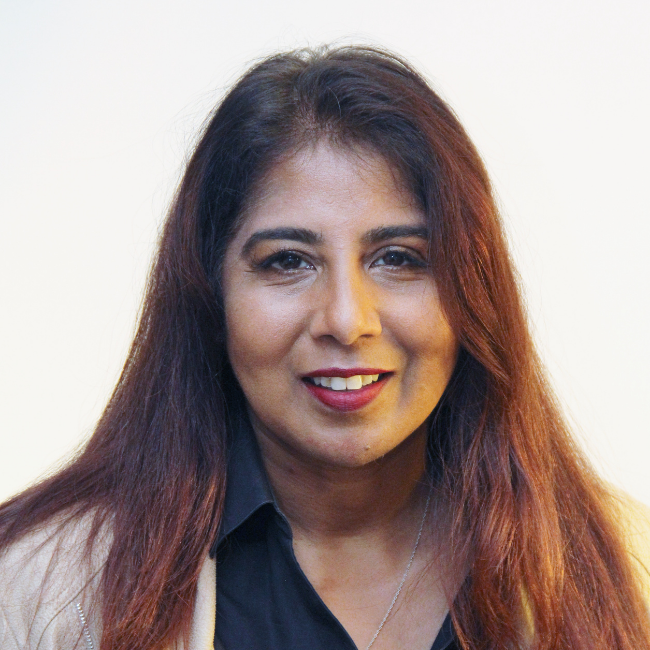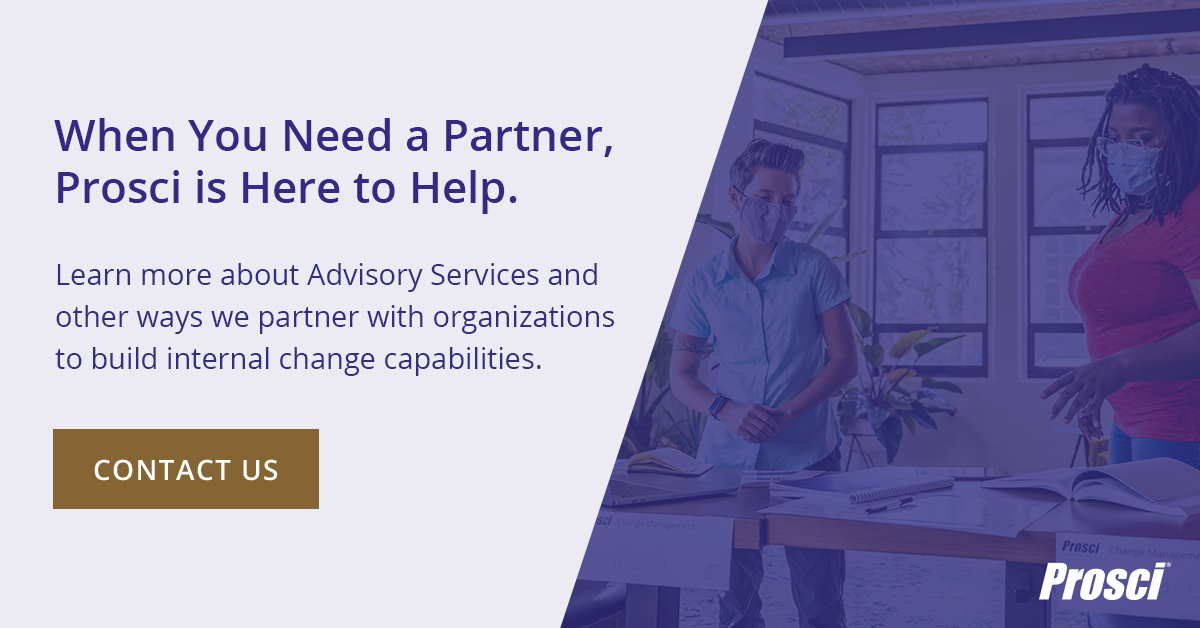The Unique Role of Change Management Advising

4 Mins
Updated: August 8, 2024
Published: November 4, 2020

Like so many, I came to change management through a first career. Mine was the learning and development world, where we created blended learning solutions for different types of implementations. But people were not coming to the sessions ready to learn. Their first questions were, “Why do I need to learn this?” and “Why are we going through this change?” We were missing something. That’s when I discovered the value of change management.
Advisory Work Is Not Consulting
Being a Senior Change Advisor is a culmination of all my previous roles: project manager, L&D consultant, communications lead, change leader, consultant and Executive Instructor. Now I use a holistic approach to help foster change management Knowledge and Ability inside organizations and develop their internal capabilities to the extent that it becomes second nature.
Traditionally, a consultant leans into a depth of knowledge and expertise. The goal is to design and implement a solution, make sure it works, and then move on. Advisory work is different in that it blends being a consultant, teacher, coach and cheerleader. It’s not about me, and it’s not about telling clients what to do. I meet clients where they are to collaborate on how best to move to the next stage while developing their confidence and accelerating their projects.
Bridging the knowledge-to-ability gap
It’s common to understand a concept but stumble with a practical application. I hear people fresh out of certification say, “I learned a lot, but I don’t know where to start.” Others are further along but don’t apply their knowledge at the needed depth. Helping them move from Knowledge to Ability, to help make the big picture gel for them in a tangible, meaningful way is a big part of advisory work.
To grow ability, we look at five areas:
- Psychological barriers
- Physical abilities
- Intellectual capability
- Time available to develop needed skills
- Resources available to support the development of new aptitudes
In an advisory session, we stay faithful to what the work requires at the moment. But we maximize the Knowledge by anchoring to the Prosci Methodology and best practices. We build a person’s Ability by growing confidence in using the assessment and tools. I find that most people need a little help from an unbiased perspective to help mentally reposition around “how might we” tackle an issue.
.png?width=600&name=blog%20image-ability%20(1).png)
Enabling learning through doing
As a coach, I have a no-hands-on-the-keyboard rule. One of our great Executive Instructors, Michele Quinn, also says, “The person learning is the person doing.” Seeing someone wrestle with a concept or a next step can be challenging, but this is the very moment we want to harvest—it’s essential to the process. In coaching sessions, we create a safe place for open discussion, thought, exploration and a set of actionable next-step items. Those items often send the client down a path of asking questions or holding conversations with people who are stepping outside their comfort zones. Clients always come back with tales of their outcomes and aha moments. That’s their Ability growing and their Reinforcement kicking in. (Remember, it’s ADKAR and not ADKA!)
Building change management organizations
Advisory work is most powerful at an organizational level. Change management is a team sport—it’s not about getting a few projects over the finish line or placing all of the effort with the change lead. To implement strategies or pivot quickly in response to market demand, organizations need a shared change management mindset about using, adopting and embracing change. But where do you start? Even after attending ECM Bootcamp, the task can be daunting. Advisors run Strategic Alignment Workshops, Change Management Maturity Model Assessments, provide insights into saturation risks, and so much more. Our work is always focused around the “why” of a change, helping clients making sense of what is happening, and then helping them determine the next, best steps to take.

Removing roadblocks to success
Maybe the most critical biproduct of advisory work is helping someone find their voice. A change leader needs to be brave enough to be the one person who views things from a different perspective and doesn’t fear identifying challenges and resistance. If a project team wants to move full steam ahead, but you know the stakeholder group isn’t ready, you must be comfortable speaking up about this to your leadership and support your assertion. For this, I coach clients to provide empirical data through the Prosci assessments and ADKAR framework. Quantifiable data speaks to those in charge.
It can also be difficult for change practitioners to get key people to listen because the role typically comes with more responsibility than authority. Often certification participants pull me aside to share their struggles with not being heard and recommendations not being accepted, even though they understand the situation and the tactics required to be successful. Fortunately, their Change Management Certification training and tools equip them for these situations, but it’s not always enough. My role as an advisor is to coach them through situations and offer that outside perspective they need. And whenever a client reaches a new level of success, I’m their biggest cheerleader.
We don’t often talk about personal roadblocks to success as a change practitioner, but they exist. The issue compounds for women, younger and older practitioners, and minorities. As a woman and person of color, it’s common for me to walk into a room and be the only Black person there. I feel both the weight and the pride of that. We all have concerns that could hold us back, but I know now that they are experiences that make you strong.
A Different Kind of Leadership
Having spent most of my career on projects, I have experienced various industries, project complexities, and regional considerations. If it has happened on the project floor, I have probably seen it. This broad perspective enables me to help practitioners grow more successful in their roles. Change practitioners must also be excellent at a different kind of leadership, which I call leading from behind. To do it well requires in-depth technical knowledge, and the ability to let go of self-limiting doubts and personal concerns. That enables you to speak with authority and authenticity, and find your voice. When you reach that point, you can be far more successful as an advisor or a change leader.


